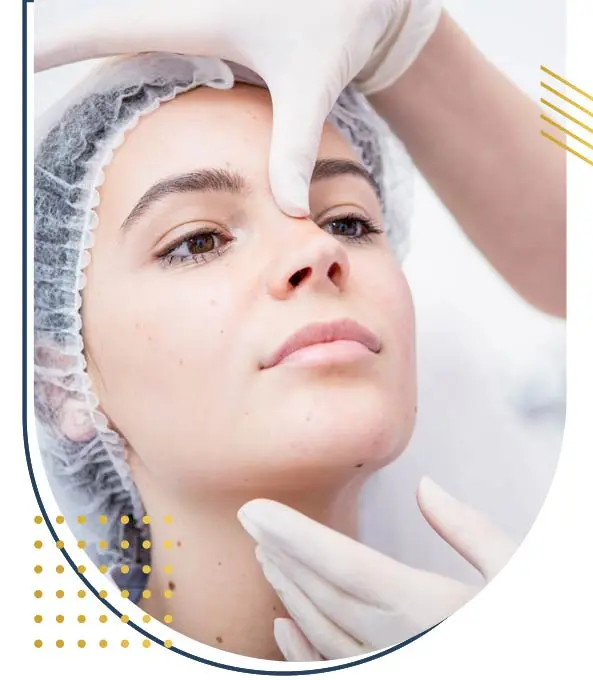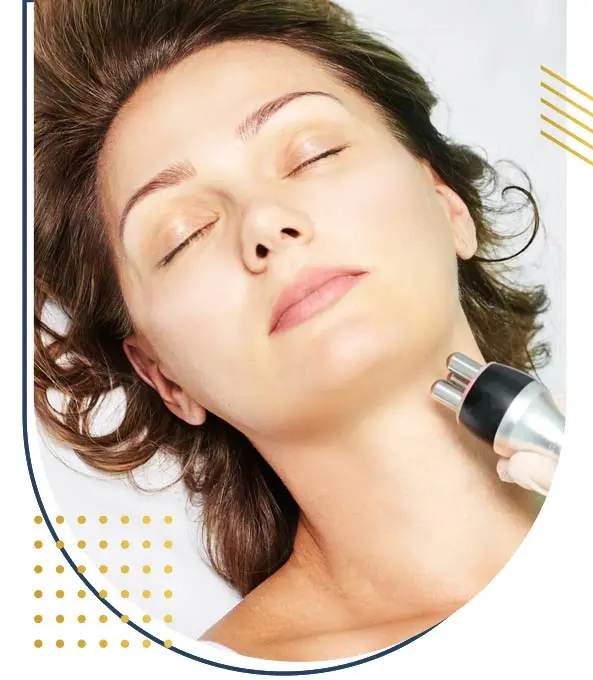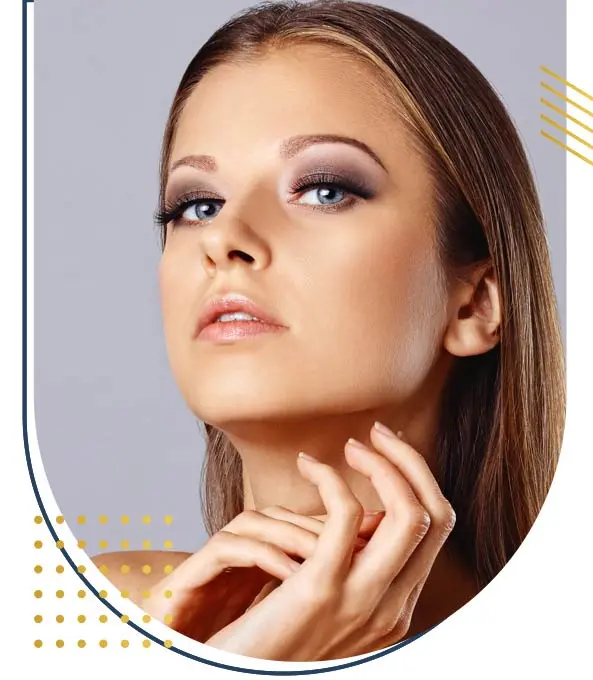
With time, the face loses its firmness and aging signs appear, but fortunately there are several techniques to rejuvenate the face and restore its radiance for a youthful appearance.
Facial fat transfer realized in Egypt is also known as facial fat transfer grafting, it is a technique that consists of transferring one's own excess from the different areas of the body such as the buttocks, belly, thighs, arms… to reinject it into the face so as to rejuvenate it.
Facial fat transfer price in Egypt
The price facial fat transfer Egypt is advantageous, so, ask for a free online quote by filling in the quotation request form on our website to obtain facial fat transfer cost Egypt or contact us by phone on the phone numbers you will find on our website for more details and information about this fat transfer to face surgery.
What are the types of the Facial fat transfer procedure ?
Microfat Transfer :
Microfat transfer is a sophisticated method used in facial rejuvenation, characterized by the precise extraction and injection of minute fat droplets to restore volume and contour to the face. This technique involves the delicate harvesting of fat from donor areas, such as the abdomen or thighs, through a specialized liposuction process.
The extracted fat is then carefully processed to isolate small clusters of fat cells known as micrografts. These micrografts are rich in viable adipocytes and stromal cells, ensuring a higher rate of survival post-injection.
The surgeon strategically injects these micrografts into targeted areas of the face using fine cannulas, allowing for meticulous sculpting and enhancement of facial features. Microfat transfer is particularly effective in addressing subtle volume loss, fine lines, and hollows under the eyes.
By restoring youthful fullness and vitality to the skin, this technique achieves natural-looking results with minimal downtime, providing patients with a refreshed and rejuvenated appearance.

Nano-Fat Transfer :
Nano-fat transfer represents a revolutionary approach to facial rejuvenation, leveraging the regenerative properties of ultra-refined fat particles to enhance skin quality and texture.
Unlike traditional fat transfer methods that utilize larger fat grafts, nano-fat transfer involves the emulsification and filtration of harvested fat tissue to obtain tiny fat droplets containing a high concentration of regenerative stem cells and growth factors.
These nano-sized fat particles are then meticulously injected into the superficial layers of the skin using fine-gauge needles or microcannulas. Upon injection, the nano-fat stimulates collagen production, promotes tissue regeneration, and improves overall skin elasticity and tone. This technique is highly effective in treating fine lines, wrinkles, acne scars, and uneven skin texture, making it an ideal option for patients seeking non-surgical facial rejuvenation.
Nano-fat transfer can be combined with other cosmetic procedures, such as microneedling or laser therapy, to amplify its effects and achieve optimal results. With its ability to rejuvenate and revitalize the skin from within, nano-fat transfer offers patients a natural and long-lasting solution for achieving radiant and youthful-looking skin.
Coleman Technique :
The Coleman Technique, developed by renowned plastic surgeon Dr. Sydney Coleman, represents a paradigm shift in the field of facial fat grafting with its meticulous approach to fat harvesting, processing, and injection.
This technique begins with the gentle liposuction of excess fat from donor sites, such as the abdomen or flanks, using specialized cannulas designed to minimize trauma to the fat cells. The harvested fat is then processed using centrifugation or filtration to remove excess fluids and debris, resulting in a purified fat graft with a high concentration of viable adipocytes and stromal cells.
The purified fat is meticulously injected into targeted areas of the face using blunt-tipped cannulas, allowing for precise placement and contouring of facial features.
By layering small aliquots of fat in multiple planes, the Coleman Technique achieves natural-looking results with minimal risk of irregularities or lumps. This approach aims to optimize fat graft survival and integration, ensuring long-lasting outcomes that evolve with the patient's aging process.
With its emphasis on precision and artistry, the Coleman Technique continues to be widely recognized as a gold standard in facial fat grafting, providing patients with natural and harmonious facial contours.
Platelet-Rich Plasma (PRP) Enhanced Fat Transfer :
Platelet-Rich Plasma (PRP) enhanced fat transfer combines the regenerative properties of PRP with the volumizing effects of autologous fat grafting to achieve comprehensive facial rejuvenation.
This innovative procedure begins with the collection of a small amount of the patient's blood, which is centrifuged to isolate PRP, a concentrated source of growth factors and cytokines essential for tissue repair and regeneration.
The harvested fat is then mixed with PRP before being injected into targeted areas of the face, such as the cheeks, lips, or nasolabial folds. The combination of PRP with fat grafts enhances graft survival, stimulates collagen production, and accelerates tissue healing, resulting in smoother, firmer, and more youthful-looking skin.
PRP enhanced fat transfer is particularly beneficial for patients seeking natural and long-lasting facial rejuvenation without the need for synthetic fillers or implants. By harnessing the body's own healing mechanisms, this procedure achieves subtle yet significant improvements in facial volume, contour, and overall appearance, restoring a youthful and refreshed aesthetic.
Stem Cell-Enriched Fat Transfer :
Stem cell-enriched fat transfer represents the pinnacle of facial rejuvenation techniques, offering unparalleled regenerative potential and aesthetic enhancement through the use of adipose-derived stem cells (ADSCs). This advanced procedure begins with gentle liposuction to harvest excess fat from donor sites, followed by processing to isolate ADSCs from the harvested fat tissue.
These multipotent stem cells possess the unique ability to differentiate into various cell types, regenerate damaged tissues, and modulate the body's inflammatory response, making them invaluable for tissue repair and rejuvenation.
The enriched fat graft, containing a high concentration of ADSCs, is then meticulously injected into targeted areas of the face to restore volume, improve skin quality, and promote overall facial rejuvenation. Stem cell-enriched fat transfer offers numerous advantages over traditional fat grafting methods, including enhanced graft survival, accelerated tissue healing, and long-lasting results. By harnessing the regenerative power of stem cells, surgeons can achieve natural and youthful facial contours that endure the test of time, providing patients with transformative outcomes and renewed confidence in their appearance.
Autologous Fat Transfer :
Autologous fat transfer, also known as fat grafting or fat injection, is a versatile procedure used to restore volume and contour to the face using the patient's own fat tissue.
This technique begins with gentle liposuction to harvest excess fat from donor areas, such as the abdomen, thighs, or flanks. The harvested fat is then carefully processed to remove excess fluids and debris before being reinjected into targeted areas of the face, such as the cheeks, lips, or temples.
Autologous fat transfer offers natural-looking results with minimal risk of allergic reactions or rejection since the fat tissue is sourced from the patient's own body. This procedure is highly customizable, allowing surgeons to sculpt and enhance facial features with precision, achieving a rejuvenated and harmonious aesthetic. Additionally, autologous fat transfer has the added benefit of simultaneously contouring donor areas, resulting in a more sculpted and proportionate physique overall.
Structural Fat Grafting :
Structural fat grafting is a specialized technique used to restore volume and support to the deeper layers of the face, particularly in areas where age-related fat loss has led to hollowing or sagging. Unlike traditional fat transfer methods that focus on superficial augmentation, structural fat grafting aims to recreate the underlying support structure of the face, providing a natural and long-lasting rejuvenation.
This technique involves the strategic placement of larger fat grafts in deeper planes of the face, such as the cheeks, chin, or jawline, to enhance facial contours and restore youthful fullness. By carefully sculpting and layering fat grafts, surgeons can achieve a three-dimensional improvement in facial volume and symmetry, resulting in a more balanced and harmonious appearance.
Structural fat grafting is particularly effective in addressing age-related changes, such as midface volume loss or hollowing around the eyes, providing patients with natural and enduring results that age gracefully over time.
Composite Fat Grafting :
Composite fat grafting combines autologous fat transfer with other tissue components, such as dermal grafts or platelet-rich plasma (PRP), to achieve enhanced volume restoration and tissue regeneration. This advanced technique is especially beneficial for patients with significant facial volume loss or skin laxity, as it addresses multiple aspects of facial aging simultaneously.
The procedure begins with the gentle liposuction of excess fat from donor areas, followed by processing to isolate the fat grafts. These fat grafts are then combined with additional tissue components, such as dermal matrix or PRP, to create a composite graft with enhanced regenerative properties.
The composite graft is meticulously injected into targeted areas of the face, providing volumetric support and stimulating tissue regeneration. Composite fat grafting offers natural-looking results with long-lasting benefits, as it addresses both volume loss and skin quality issues associated with aging. By harnessing the synergistic effects of multiple tissue components, surgeons can achieve comprehensive facial rejuvenation and restore a youthful and vibrant appearance to the face.
Facial fat transfer Egypt :for whom ?
Facial fat transfer realized in Egypt is for patients who are in a good health, who have excess fat in different areas of the body as the buttocks, thighs, belly, hips…to be transferred to the face.
It is indicated for patients with horizontal forehead wrinkles, frown lines, crow's feet, nasolabial folds, bitterness folds…
This procedure is for all patients who want to restore volume to the face and rejuvenate it for a more youthful appearance, it is performed after a consultation with the surgeon who will examine your facial features and silhouette, your health and evalute your medical history to check whether you are suitable for this technique or not.
Before your intervention
Before your facial fat transfer Egypt, you will consult the surgeon to evaluate your health, examine you and explain you the whole process of this procedure including its recovery time, results, advantages…
You will have to follow all his recommendations.
Taking aspirin must be stopped 6 weeks before the operation.
Smoking must also be stopped before and after the intervention.
A complete medical check up and blood analysis must be realized before your facial fat grafting Egypt.
How is it performed ?
Facial fat transfer in Egypt is realized under general anaesthesia.
The fat is harvested with a special suction cannula using a sterile technique. Once enough fat has been obtained from the donor areas (the thighs, buttocks, hips, arms, belly…) through liposuction, it is then purified. This often involves the use of a centrifuge which spins the fat and removes impurities.
The fat is then placed in the facial parts that will be treated. The injection needle is usually passed in and out of the concerned areas several times.
This is done to create a grid of the entire grafted area. The parts of the face that have been injected can then be massaged by the surgeon to create a satisfactory contour. A dressing can then be placed.
Facial fat transfer Egypt :aftercare and recovery
After your facial fat transfer in Egypt, you may experience bruising and swelling that will disappear with time.
The surgeon will prescribe you painkillers to relieve the pain.
Professional activities can be resumed after a period of 2 weeks (but this depends on your case and your type of job, it will be discussed with your surgeon).
The sutures will be removed on the 5th postoperative day.
Sport and strenuous activities must be stopped (the period will be indicated by your surgeon).
Facial fat transfer Egypt results
You will be able to appreciate the first results of your facial fat transfer realized in Egypt after the procedure, but the final results will be visible from the 3rd to the 6th postoperative month.
It is important to know that this intervention has many benefits :
-Filling in wrinkles at the first signs of aging: horizontal forehead wrinkles, frown lines, crow's feet, nasolabial folds, bitterness folds.
-Adding volume to the temples, cheekbones, under-orbital area, cheeks, oval of the face.
-Plumping the lips and redefining the lip contour.
-Giving a glow to the face.
This operation gives a natural looking, long lasting and safe. It is an effective solution to rejuvenate the face.
So, the patient will obtain a rejuvenated face and a youthful appearance which will allow him to regain self confidence and improve his quality of life on personal and social level.
What are the risks of the Facial fat transfer procedure ?
Infection :
As with any surgical procedure, there is a risk of infection at the site of fat harvesting or injection. Surgeons take precautions to minimize this risk, such as maintaining sterile conditions during the procedure and prescribing antibiotics post-operatively.
However, infection can still occur, leading to complications that may require additional treatment.
Swelling and Bruising :
Swelling and bruising are common side effects of facial fat transfer and typically resolve within a few weeks. However, in some cases, swelling and bruising may be more pronounced or prolonged, affecting the aesthetic outcome of the procedure.
Patients are advised to follow post-operative care instructions provided by their surgeon to help minimize swelling and bruising.
Asymmetry :
Achieving perfect symmetry with facial fat transfer can be challenging, and there is a risk of asymmetry between the treated and untreated areas of the face.
While surgeons strive for balance and harmony during the procedure, subtle differences in fat graft survival or placement may result in asymmetrical results. In some cases, additional touch-up procedures may be necessary to correct asymmetry.
Fat Resorption :
One of the inherent challenges of facial fat transfer is the unpredictability of fat graft survival. While surgeons take steps to optimize fat graft survival, such as proper harvesting and processing techniques, some degree of fat resorption is inevitable.
This means that not all of the transferred fat cells may survive long-term, leading to a gradual loss of volume over time. Patients may require additional fat transfer procedures to maintain their desired results.
Overcorrection or Undercorrection :
Achieving the desired level of correction with facial fat transfer requires careful planning and execution. There is a risk of overcorrection, where too much fat is transferred, resulting in a disproportionate or unnatural appearance.
Conversely, there is also a risk of undercorrection, where insufficient fat is transferred, and the desired results are not achieved. Surgeons aim to strike a balance between these extremes to achieve natural-looking and harmonious results.
Nerve Damage :
Facial fat transfer involves injecting fat grafts into delicate facial tissues that are rich in nerves. While surgeons take care to avoid vital structures during the procedure, there is a risk of nerve damage, which can result in temporary or permanent sensory changes, numbness, or tingling in the treated areas.
Most cases of nerve damage are temporary and resolve on their own over time, but in rare instances, permanent nerve injury may occur.

Scarring :
Although facial fat transfer is considered a minimally invasive procedure, there is still a risk of scarring at the donor sites where liposuction is performed.
Surgeons use small incisions and advanced techniques to minimize scarring, but individual healing responses can vary. Patients with a history of keloid or hypertrophic scarring may be at higher risk of developing noticeable scars.
Allergic Reaction :
Since facial fat transfer utilizes the patient's own fat tissue, the risk of allergic reaction or rejection is minimal.
However, there is still a small risk of allergic reaction to medications or materials used during the procedure, such as anesthesia or surgical instruments. Patients should inform their surgeon of any allergies or sensitivities they may have to ensure appropriate precautions are taken.

